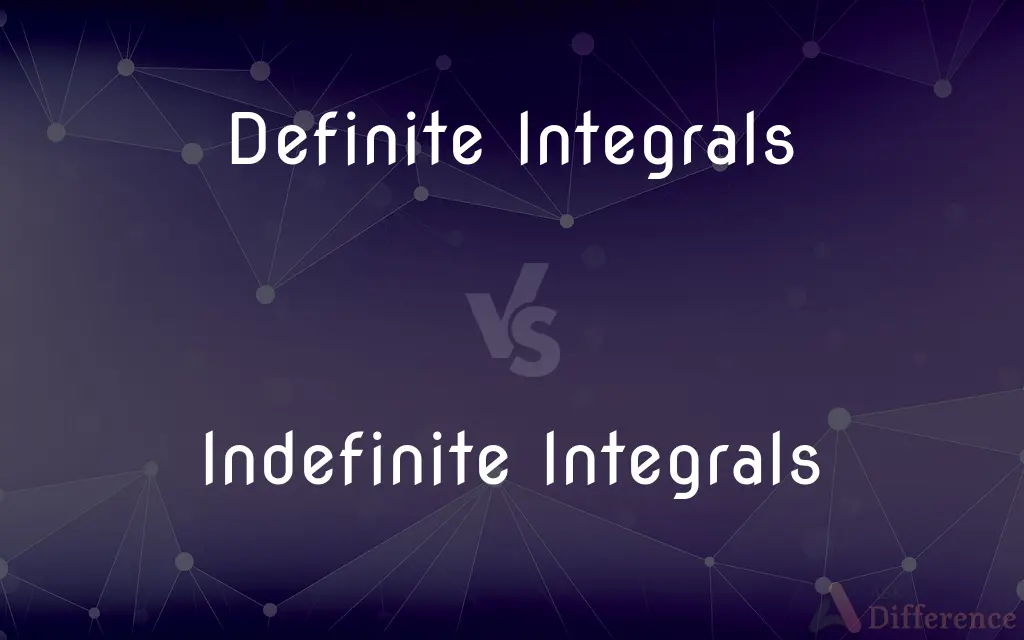Definite Integrals vs. Indefinite Integrals — What's the Difference?
Edited by Tayyaba Rehman — By Fiza Rafique — Published on December 31, 2023
Definite Integrals compute the signed area under a curve, yielding a number, while Indefinite Integrals find the antiderivative, producing a function plus a constant.

Difference Between Definite Integrals and Indefinite Integrals
Table of Contents
ADVERTISEMENT
Key Differences
Definite Integrals represent the net area between the function and the x-axis over a specified interval. Indefinite Integrals, on the other hand, are general antiderivatives of functions without specified bounds.
When calculating Definite Integrals, you consider the interval [a, b] and compute the net area between these bounds. Indefinite Integrals lack such boundaries and represent families of functions that differ by a constant.
In notation, Definite Integrals are expressed with both lower and upper limits on the integral sign. Indefinite Integrals use the same symbol but without these bounds, emphasizing their generality.
The result of a Definite Integral is always a real number. In contrast, the outcome of an Indefinite Integral is a function, often accompanied by the constant of integration, usually denoted by 'C'.
While Definite Integrals have direct applications in finding areas and volumes, Indefinite Integrals are foundational in solving differential equations and representing functions whose derivatives are known.
ADVERTISEMENT
Comparison Chart
Nature
Compute the net area under a curve.
Determine the antiderivative of a function.
Result
A real number.
A function plus a constant.
Notation
Integral sign with upper and lower limits.
Integral sign without limits.
Applications
Areas, volumes, average values.
Solutions to differential equations, antiderivatives.
Dependency on bounds
Depends on specified [a, b] interval.
Independent of any specific interval.
Compare with Definitions
Definite Integrals
A numerical value representing accumulation over an interval.
The work done by a force over a distance is computed using a Definite Integral.
Indefinite Integrals
An expression representing families of functions differing by a constant.
The Indefinite Integral of cos(x) is sin(x) + C.
Definite Integrals
The signed sum of function values over a range.
Using Definite Integrals, we can compute the total change in a quantity.
Indefinite Integrals
An integral without specified bounds.
The Indefinite Integral provides a general solution to a differential equation.
Definite Integrals
An integral with both upper and lower bounds specified.
To find the area between two curves, one often uses Definite Integrals.
Indefinite Integrals
A tool to find functions given their rates of change.
If you know the rate at which water fills a tank, the Indefinite Integral can tell you the total volume over time.
Definite Integrals
The net area under a curve between two specified limits.
The Definite Integral from 0 to 1 of x^2 dx gives the area under the curve y = x^2 between those points.
Indefinite Integrals
The general antiderivative of a function.
The Indefinite Integral of 2x is x^2 + C.
Definite Integrals
A measure of total effect over a specified domain.
The total displacement of a particle can be found using a Definite Integral.
Indefinite Integrals
A symbolic representation of all possible antiderivatives.
The Indefinite Integral of e^x covers all functions whose derivative is e^x.
Common Curiosities
What is the outcome of an Indefinite Integral?
The outcome of an Indefinite Integral is a function, often accompanied by a constant of integration.
Can Definite Integrals yield negative values?
Yes, Definite Integrals can yield negative values if the function lies below the x-axis over the interval.
Why is there a constant 'C' in Indefinite Integrals?
The constant 'C' accounts for the arbitrary constant that arises when determining the antiderivative.
Are Definite Integrals always real numbers?
Yes, the result of a Definite Integral is always a real number, representing a signed area or accumulated value.
How are Definite Integrals related to Riemann sums?
Definite Integrals can be approximated using Riemann sums, which partition the interval and sum function values.
Why are Indefinite Integrals termed "indefinite"?
They're termed "indefinite" because they represent a family of functions without a definite value, differing by a constant.
What do Definite Integrals measure?
Definite Integrals measure the net area under a curve between two specified limits.
How do I evaluate a Definite Integral?
A Definite Integral is often evaluated using the Fundamental Theorem of Calculus, relating it to an antiderivative.
Do Indefinite Integrals have applications in physics?
Yes, Indefinite Integrals are foundational in solving differential equations, often arising in physics and engineering.
Can the result of an Indefinite Integral be plotted?
Yes, the result of an Indefinite Integral is a function, and it can be plotted on a graph.
Can Definite Integrals be used in probability?
Yes, Definite Integrals are used to compute probabilities in continuous probability distributions.
Share Your Discovery

Previous Comparison
Cookies vs. Biscuits
Next Comparison
DLL vs. PLLAuthor Spotlight
Written by
Fiza RafiqueFiza Rafique is a skilled content writer at AskDifference.com, where she meticulously refines and enhances written pieces. Drawing from her vast editorial expertise, Fiza ensures clarity, accuracy, and precision in every article. Passionate about language, she continually seeks to elevate the quality of content for readers worldwide.
Edited by
Tayyaba RehmanTayyaba Rehman is a distinguished writer, currently serving as a primary contributor to askdifference.com. As a researcher in semantics and etymology, Tayyaba's passion for the complexity of languages and their distinctions has found a perfect home on the platform. Tayyaba delves into the intricacies of language, distinguishing between commonly confused words and phrases, thereby providing clarity for readers worldwide.













































